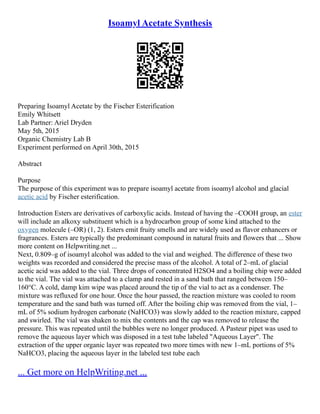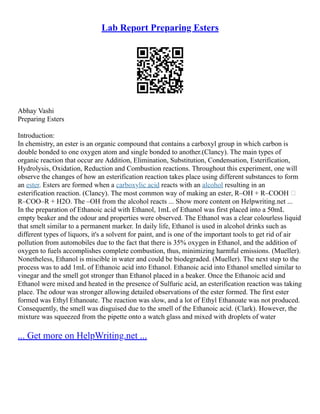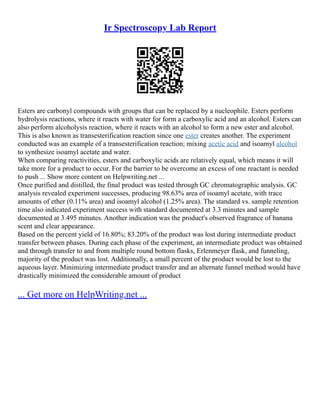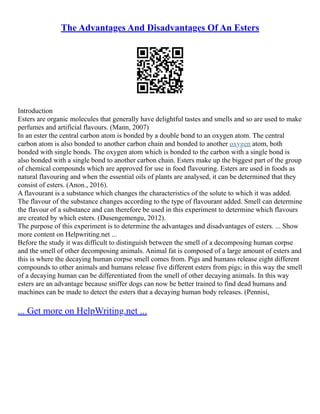The document describes an experiment to prepare isoamyl acetate by Fischer esterification. Isoamyl alcohol and glacial acetic acid are reacted in the presence of sulfuric acid as a catalyst. The reaction is refluxed for one hour to form the ester, which is then extracted from the reaction mixture using sodium hydrogen carbonate. Characterization of the product is not described in the given text.







![Synthesis Of Esters
Esters aromas are very distinct and often pleasant, they are often used in food aroma and fragrances.
Esters chemical properties are distinguished by their low molecular weight and low boiling points,
caused by their dipole–dipole and dispersion interactions; additionally, esters cannot form hydrogen
bonds. Esters are the result of a condensation reaction, in which a carboxylic acid, an alcohol, and
acid catalyst creates a water molecule and an ester. In a condensation reaction the carboxylic acid
and alcohol react in a way that causes at least one alkyl or benzene ring group replaces a
hydroxyl(OH) group. Amides like esters can be formed by a condensation reaction involving
carboxylic acid, which reacts with amine, to form an amide and water. ... Show more content on
Helpwriting.net ...
With the dried mass of the product the balanced equation of the reaction, between 4–aminophenol
and acetic anhydride can be calculated. The percent yield of said product can then be calculated by
divided the calculated mass by the theoretical mass. Using the characteristics of alcohols and pH,
the 4–aminophenol and acetaminophen produced can be tested to categorize which are alcohols and
the pH of each. In the Cerium Test the reaction between [Ce(H2O)6]4+ and HO–R(alcohol) will
produced [(H2O)5Ce–O–R]3+, the (R) group will produce a color change in the product allowing
for the characterization of a reactant as either an alcohol or not. In the Universal Indicator Test
adding universal indicator to an aqueous mixture of any alcohol, amide, or amine will result in a
color change, red for acidic and blue for basic. Then by using the knowledge that alcohols and
amides register as pH neutral and amines register as slightly acidic allows for the characterization of
the reactant as an alcohol or amide, or as an amine. In the last part of the experiment, an alcohol and
an acetic acid will react in an esterification reaction to produce an ester. Using the ester odors in the
known ester banks, the unique aroma of each ester will allow for a categorization of each ester
produced. Lastly, retrosynthetic analysis can be used to
... Get more on HelpWriting.net ...](https://image.slidesharecdn.com/isoamylacetatesynthesis-231118171928-e784c8f5/85/Isoamyl-Acetate-Synthesis-8-320.jpg)

























![Tests on the Medical Effectivness of Phlomis...
Phlomis Younghusbandii Mukerjee is a perennial herb (family Labiatae) and grows wildly in
Qinghai–Tibet Plateau of China. It has been widely used to treat colds, coughs, sores ulceration,
rheumatoid arthritis, pneumonia, bronchitis and other diseases for thousands years. In this paper, 5
iridoid glycosides (sesamoside, shanzhiside methylester, 7, 8–dehydropenstemoside, penstemoside
and 8–O–acetylshanzhiside methylester) and 3 phenylethanoid glycosides (acteoside, alyssonoside,
and isoacteoside) in the four samples from different places were analyzed by HPLC. The acetic
acid–induced writhing test, the hot plate test, the carrageenan–induced paw edema test, the xylene–
induced ear swelling test, and the acetic acid–induced Evans blue leakage ... Show more content on
Helpwriting.net ...
Younghusbandii[2–7].
Iridoid glycosides and phenylethanoid glycosides with antinociceptive and anti–inflammatory
activities have been isolated from several plants of genus Phlomis [8–9].In our recent study, the
related plants, Phlomis umbrosa Turcz and Lamiophlomis rotata (Benth.) Kudo, have showed
significant antinociceptive and anti–inflammatory activities in several animal models[10–11].At the
same time,six iridoid glycosides: sesamoside,shanzhiside methyl ester, 7,8–dehydropenstemoside,
penstemoside, 8–O–acetylshanzhiside methyl ester, phlomiol and three phenylethanoid glycosides:
acteoside, alyssonoside, and isoacteosidewere isolated and identified from P. Younghusbandii.
Among of these compounds, 7, 8–dehydropenstemoside, and three phenylethanoid glycosides were
isolated from this plant for the first time [12].In this paper,the acetic acid–induced writhing test, the
hot plate test, the xylene–induced ear swelling test, and the acetic acid–induced Evans blue leakage
test were used to investigate the antinociceptive and anti–inflammatory activities of the aqueous
extract of this plant.5–iridoid glycosides (sesamoside, shanzhiside methylester, 7, 8–dehydro–
penstemoside, penstemoside and 8–O–acetyl–shanzhiside methylester) (Fig. 2)and 3–
phenylethanoid glycosides (acteoside, alyssonoside, and isoacteoside) (Fig. 3)in three samples of P.
Younghusbandii from different places were
... Get more on HelpWriting.net ...](https://image.slidesharecdn.com/isoamylacetatesynthesis-231118171928-e784c8f5/85/Isoamyl-Acetate-Synthesis-34-320.jpg)











































